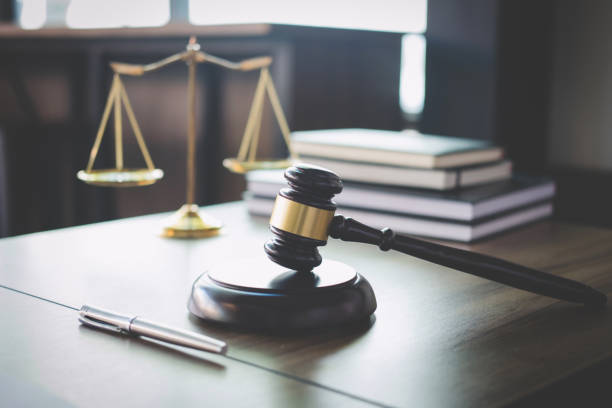Before a lawsuit is allowed to proceed in the United States, there is a question that must be answered to the satisfaction of the presiding judge. "Does the party seeking judicial relief have standing?" Okay, so what is "Legal Standing," and how is it determined? The definition is simple enough, but determining who meets that bar is often a matter of judgment of the judge or judges hearing the case.
Standing is the legal right to initiate a lawsuit. To have Standing, a person must be sufficiently affected by the matter at hand, and there must be a case or controversy that can be resolved by legal action. The judge must first decide if the person or group that has filed the complaint/challenge has been "sufficiently affected," which can sometimes be a simple matter - for example, I hit you with my car while I was driving, you have been "sufficiently affected" by that action - but then on other occasions, it's not as simple - for example; You are a taxpayer living in Florida, and the U.S. Congress raises taxes to pay for a program that will only operate in the Pacific Northwest, the court is likely to find that you are not "sufficiently affected" to sue to stop Congress from raising your taxes as all taxpayers are subject to the authority of Congress as they are operating within their Constitutional responsibilities. If the court rules that you are "sufficiently affected," then you are one step closer but still do not have standing yet.
Next, the court must decide if it is appropriate to intervene in the matter at hand. Is there clear, Constitutional law or legal case precedent that should be upheld and would end the dispute hand? Or, is the question outside the judicial branch's or government's preview altogether? Once both of the questions of "sufficiently affected" and "can be resolved by legal action" have been answered, the case may move forward.
Standing is a Constitutional principle designed to prevent government overreach and protect individual rights. However, given the nature of determining the question of Standing, an effort to apply the principle in a consistent manner, requirements for Standing have been created in case law.
Lujan v. Defenders of Wildlife established three requirements for Article III standing:
1.) Injury in fact, meaning an invasion of a legally protected interest that is (a) concrete and particularized, and (b) actual or imminent, not conjectural or hypothetical.
2.)A causal relationship between the injury and the challenged conduct, meaning that the injury can be traced to the challenged action of the defendant and has not resulted from the independent action of some third party not before the court.
3.) A likelihood that the injury will be redressed by a favorable decision, meaning the prospect of obtaining relief from the injury as a result of a favorable ruling is not too speculative.
Warth v. Seldin found that in deciding Standing, a court must consider the allegations of fact contained in that person or group's declaration and other affidavits supporting that assertion of Standing. And when addressing a motion to dismiss due to lack of Standing, the court must accept as true all material allegations of the complaint and must construe the complaint in favor of the party claiming standing.
Over time, other cases have added more requirements via precedent, like Associated General Contractors of California v. Coalition for Economic Equity found that when an individual seeks to avail themself of the federal courts to determine the validity of a legislative action, they must show that there "is immediately in danger of sustaining a direct injury." And that this requirement is necessary to ensure that "federal courts reserve their judicial power for 'concrete legal issues, presented in actual cases, not abstractions." Someone seeking injunctive or declaratory relief "must show a very significant possibility of future harm to have standing to bring suit." via Nelsen v. King County.
So, as you can see, precedents have established cover for judges to use their judgment - and personal prejudices - rather than well-established law in making determinations about Legal Standing. This leads us back to the question asked in the title of this piece. Has "Legal Standing" transitioned from a Constitutional principle to limit governmental power to become a tool for activist judges who are no longer content with making rulings based on law? Two recent cases illustrate the need for the American people to ask this question.
On August 14th, 2023, District Court Judge Kathy Seeley ruled in favor of sixteen young climate activists in a case dealing with the state's fossil fuel permits. Judge Seeley ruled that the state's approval process for fossil fuel permits violates Montana's state constitution because it does not consider the effects of carbon emissions. The plaintiffs, aged five to 22, sued the state, claiming Montana's fossil fuel policies contribute to climate change. Their lawsuit cited a 1972 clause in Montana's Constitution: "the state and each person shall maintain and improve a clean and healthful environment in Montana for present and future generations." Montana Attorney General Austin Knudsen is planning to appeal the decision and will most likely win that appeal due largely to the question of Standing for the young activists who brought forth this case.
It is clear from Judge Seeley's writing, "Montana's emissions and climate change have been proven to be a substantial factor in causing climate impacts to Montana's environment," and "Plaintiffs have proven that as children and youth, they are disproportionately harmed by fossil fuel pollution and climate impacts." that the judge did not apply law to the ruling but rather their own pro-climate change belief. Without a personal bias on the question before the judge, how does Seeley justify allowing Standing to these young people? Even if you buy into the idea that being young somehow makes you disproportionately impacted by the harms of "climate change," there is still the question of "what is the likelihood that a favorable decision will fix the injury." How does making Montana consider climate change when deciding whether to approve fossil fuel projects such as power plants protect these young people when China, India, and multiple African nations continue to use fossil fuel at ever-increasing levels? Plus, what if, after considering climate change, Montana decides that the good of such a project outweighs the potential harm? Based on requirement three established in Lujan v. Defenders of Wildlife and buying into the general dogma of the Climate Change religion, Standing should not have been granted; the week-long trial should have never happened.
Also on August 14th, 2023, U.S. District Judge Thomas L. Ludington of the Eastern District of Michigan issued an 18-page order dismissing a case challenging Joe Biden's latest version of a student debt bailout., concluding that the Cato Institute and Mackinac Center for Public Policy lacked the Standing to challenge the bailout. This is after the Supreme Court smacked down the Biden administration over their earlier effort at a bailout for student debt borrowers.
The Cato Institute and Mackinac Center for Public Policy's suit claimed that the administration violated federal law by failing to produce the forgiveness policy through the traditional rulemaking process and offering the public the opportunity to comment. (Which is accurate and, if you will recall, was the same grounds that Donald Trump's efforts to end DACA were overturned.) The groups also claimed the policy would harm their recruitment efforts, which is how the groups attempted to establish their Standing. If the filing makes it clear to the court that this policy does harm recruiting for these groups and that addressing the clear violation of the Administrative Procedure Act would correct that harm, then all of the criteria for Standing have been met. So why did Judge Ludington deny Standing? Reading through his 18-page order, at the bottom of page two, Ludington simply stated that "the Plaintiffs, in this case, cannot show such concrete particularized injury and, even if they could, Plaintiffs cannot show causation." No explanation as to why he determined this to be true, just a statement that it is the case. Did the original filing fail to prove the harm to recruiting or that a favorable ruling would correct the issue? Or did Judge Ludington not want to assist conservatives in stopping Joe Biden's attempts to bribe voters going into election season? Either way, it is an awfully convenient excuse not to address the obvious violation of the Administrative Procedure Act committed by the Biden administration. (Just as an FYI, Sheng Li, an attorney at the New Civil Liberties Alliance, which is representing the conservative groups in the lawsuit, said, "We disagree with the court's conclusion regarding legal Standing and are reviewing our legal options.")
Given that we are now living in a time where it appears that the Department of Justice has been weaponized to attack political opposition and protect those in power, it feels vital that we restore integrity to all aspects of the judiciary system from the front line of law enforcement to each member of the highest court in the land. Officers and Agents can not behave as if they are above the law; attorneys and judges can not act as if they can re-write the law; personal politics can not be allowed to interfere with the execution of assigned duties. And most importantly, the Constitution must be recognized as the supreme law of the land, not just something to work around in order to get what you want. Otherwise, all is lost. Can we start by agreeing on defining who does and who does not have Standing?



















